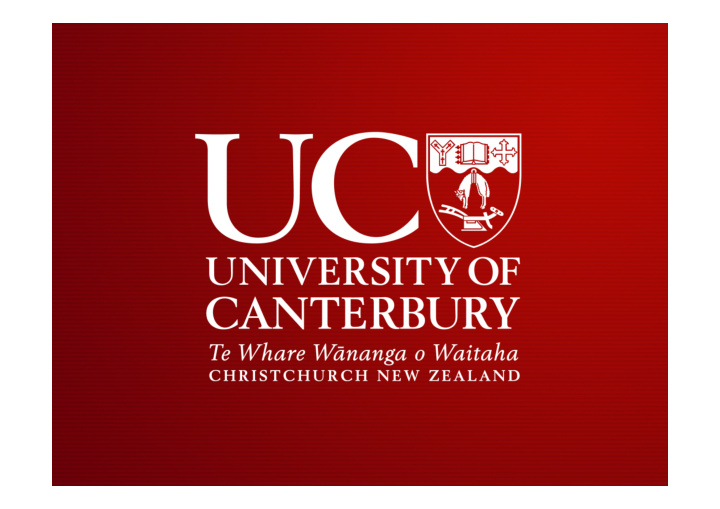



IREG ‐ 6 Conference, Taipei, 2012 Institutional Perspectives on the Strategic Impact of Rankings – Implications from a Case Study of the University of Canterbury (NZ)
ABOUT THE UNIVERSITY OF CANTERBURY Key Statistics • Enrollment & Staff (as of September 2011) • 18,175 students (headcount) • 1,324 international students (headcount) • 589 continuing academic staff (FTE), of 1,568 total continuing staff (FTE) • Organized in five colleges (Arts, Business & Economics, Education, Engineering, Science) and the School of Law • Research Strengths • Host of 25 research centers across all fields • Consistently scoring in the top 500 ARWU (Shanghai Ranking) since 2003 • UC engineering faculty as NZ leading expert in civil engineering • UC faculty devised building standards for New Zealand
ABOUT THE UNIVERSITY OF CANTERBURY ARWU Ranking with International Peers University of Canterbury and International Peers ARWU 2003-2011 Rankings 0 Auburn University 50 100 University of Auckland 150 200 University of Canterbury 250 University of Essex 300 350 University of Hannover 400 450 University of Otago 500 2003 2004 2005 2006 2007 2008 2009 2010 2011 Notes: Ranges have been displayed with their top value; institutional ranks have been modified to accommodate data display. Source: ARWU.
ABOUT THE UNIVERSITY OF CANTERBURY QS Ranking with New Zealand Peers University of Canterbury and New Zealand Peers QS 2004-2011 Rankings 0 46 50 52 61 65 67 50 68 University of Auckland 82 79 114 100 124 125 130 114 135 150 186 University of Otago 200 186 188 188 189 212 250 University of Canterbury 300 333 350 2004 2005 2006 2007 2008 2009 2010 2011 Notes: From 2005 to 2009, the rankings refer to the joint THE‐QS Rankings; for 2010 and 2011, the rankings refer to the QS Rankings alone. Source: QS.
ABOUT THE UNIVERSITY OF CANTERBURY An Institutional View on Past Rankings Performance • UC has ranked consistently in the Top 500 universities worldwide overall: • ARWU 401 ‐ 500 (2011) • QS ‐ US News 212 (2011 ‐ 12) • THE ‐ TR 301 ‐ 350 (2011 ‐ 12) • THE ‐ TR’s methodology appears to treat UC differently than the past THE ‐ QS (now QS ‐ US News) methodology • Webometrics results are interesting, too (rank 449, as of January 2012): • Rich files 790 (was 830 in 2011) • Visibility 644 (was 638 in 2011) • Scholar 349 (was 155 in 2011) Do these rankings do UC’s academic performance justice, and how can UC improve its rankings performance?
ABOUT THE UNIVERSITY OF CANTERBURY Number 1 in Earthquakes Source: GeoNet, 2011.
ABOUT THE UNIVERSITY OF CANTERBURY The Rankings Strategy Project • UC faces a number of challenges going forward • Multiple local impact issues due to the series of earthquakes • Budget cuts owing to a loss of enrollments • Recruiting challenges • UC’s rankings positions are an important aspect of communicating UC’s academic strength and value proposition to the outside world • The Rankings Project was conceived as a small scale, enabling project • Research (rankings, dynamics) • Educate (internal stakeholders) • Professionalize (response approach and feedback loops) • Communicate (internally as well as externally) A holistic approach
ABOUT THE UNIVERSITY OF CANTERBURY Strategic Perspectives • External perspectives • The structural appeal of rankings to stakeholders (e.g. students, parents, agents, media, policy ‐ makers, etc.) • The (growing) impact of rankings on stakeholder behavior (e.g. employers , scholarship agencies) • Belief systems and views held by influencers in the higher education community • The development trajectory and scope of major rankings • Internal perspectives • Ownership of rankings (administration, academics) • Communication flow (into and within UC) • Data gathering and preparation (within UC) • Process improvement (within UC, and externally) • Feedback loops (use rankings for internal improvements) The nature and impact of rankings continues to be less well understood than often believed
ABOUT THE UNIVERSITY OF CANTERBURY Limitations and Challenges on Rankings Strategies • External limitations and challenges • Some rankings are highly technical (e.g. Webometrics) and thus measure highly specific technical aspects • Some rankings focus on specific attributes (e.g. ARWU) and thus may not capture the overall academic performance of UC • UC’s remoteness negatively impacts its performance in surveys which are based on familiarity/network ‐ effects (despite UC’s well developed academic relationships) • Internal limitations and challenges • No desire to “manipulate” rankings • Buy ‐ in across the organization • Lack of resources to create strong performance push (and need challenge to overcome damage from earthquakes) No ranking really captures the UC experience and value added to students
ABOUT THE UNIVERSITY OF CANTERBURY Outlook • UC will become more strategic in its rankings behavior • Despite this behavioral change, it is unlikely that notable changes in UC’s rankings will take place (in a sense, this is just keeping up with other institutions doing the same) • UC will suffer in rankings’ categories which rely on certain ratios (international students ratios, etc.) owing to post ‐ earthquake enrollment losses • UC should do better (be more proactive) with regard to rankings which gather institutionally reported information (e.g. THE ‐ TR, QS) Rankings will rise in importance, this project was only a start in adjusting institutional perspectives
Recommend
More recommend